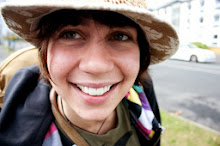Tuesday, June 2, 2009
Tuesday, April 21, 2009
Euterpe and the pianist
Euterpe's the muse of music, and for the pianist everything comes with her.
The music is not only sound, or vibration. It's solid passion, it's a touch of pure love. The pianist could be playing anything and everything he loves at the same time, when he's playing the piano. He could be playing a piece on the back of a woman. He plays inside his own head, not to destroy the sounds from the outside but only to melt them under his fingers. He's the captain of an army of noise that makes the music herself get the strongest heartbeat.
But as everything comes with the music, everything with the music goes.
Posted by Maria Galliani Dyrvik at 10:53 PM 0 comments
Monday, April 20, 2009
Sunday, April 19, 2009
The Project
In my visual music project Euterpe’s under your fingers I will try to combine a triggering of synesthesia and kinesthesia through a scene that both combines use of cinematic techinques and an exploration of human contact and movement.
The setting will be a dark theatre scene or a dark room.
The first thing a backlight will reveal is the silouhette of a man playing a dark instrument. As the lights turn on a piano will start playin. The combination of the piano and of the moves of the man playing something in the shadow will make the audience make an easy connection: they will think the man is playing a piano.
Nearer shots will show the man lightened from the front and side as well as from the back, still playing an instrument in the dark.
The piano piece will reach a first climax, and a bass will start beating at an irregular rythm.
Only then the lighting and the framing will show the scene as a whole: the man is playing the naked back of a woman. The piece will continue increasing dramatically and sensually towards a second climax, that will correspond with a close shot of the pianist’s fingers playing the neck of the woman. The music will then softly dissolve. The lights will accompain the dissolving of the tune by softly wrapping the two human fingures in darkness as well: when the pianist stops playing everything disappears.
The basic concept behind the film is to show how the musician can abstract from the real world and create one of its own in his own mind. In his mind he can play two things he loves at the same time: a piano and the back of a woman. The existence of an imaginary dimension bound to the music also means though that when the music ends, the phantasy disappears with it.
Euterpe’s under your fingers will be coreographed in a minimalist way. The dance will be enclosed between the pianist’s fingers and the womans’s back. The feeling of a dance won’t only be given by human movement, but also by lumia and by a smooth editing path, in the attempt to achieve a filmic coreography. The cutting, the movement and the cinematography will be the elements of the piece’s orchestration.
The presence of a specific kind of light near every point of contatc between the man and the woman and a smooth editing will be an attempt to trigger a synesthetic process.
The movement of the fingers and the more real and solid presence of actual human figures will try to achieve some kind of kinestetic response from the viewer, bringing him to a physical empathy with the screened images and sounds.
An important element within kinesthesia will be sensuality, to be evoked by direct contact between the man’s fingers and the nude back of the woman. Sensuality can be considerably enchanced by the lighting, as in Virginia Pitt’s Fleeting Beauty.
The future of art is light. (Henri Matisse)
In order to use the light as a proper actor and important element in the piece, cinematography will be an essential element during the production of Euterpe’s under your fingers. I will try to avoid as much as I can adjusting the lighting in post production, trying to focus on the cinematographic side of the video during production.
The lighting will not act as an indipendent, abstract character in the video. It will be an element of interaction with the human movements which are the central theme. Light scuptors and artists like Paul Friedlander or Toshio Iway are therefore an importan source of inspiration, even though my short film will be a lot less abstract than pure light art, and it will combine cinematography with other filmic techinques.
Posted by Maria Galliani Dyrvik at 12:12 AM 0 comments












